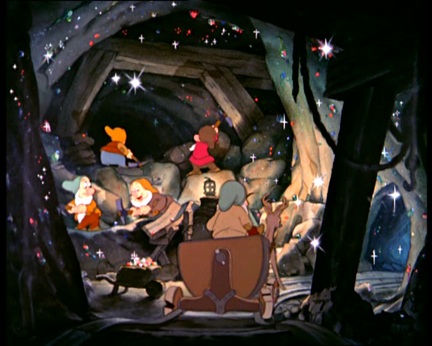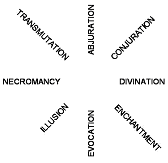Player's Handbook Rules Supplement

Nothing says “quality” like novelty fonts.
The Complete Book of Gnomes and Halflings was the 9th book in the Player's Rules Supplement series. It is about the core races that people don't care about. While it's the same length as the other Complete books, it's actually two books in one: it starts over from “chapter 1” when we get to the Halfling section. So this was obviously intended to be two books at some point, and then cut down into one on the grounds that people honestly don't care enough about Gnomes to fill an entire 128 page book. You might think that this would be the last of the PHBR series* because by this point they'd done a book for all four of the basic classes (plus Psionicist and Bard for some reason), and all of the non-human races that the PHB supported at the time (namely Dwarves, Gnomes, Halflings, and of course Elves). But there were more to come, they just weren't very “core.” The later books inclue the Humanoids book (a Player's Handbook Rules Supplement about additional information for races that are not in fact in the Player's Handbook), the Ranger's book, the Paladin's book, the Barbarian's book, the Ninja's book, and the Druid's book (which in addition to not being a fighter variant is also specifically just part of the Priest's book, considering that the book was about Priests generally and not Clerics specifically). So really, this book is the last part of the series that you could claim with a straight face was anything like “core” rather than “batshit.”
- *: Yes, they abbreviate Player's Handbook Rules Supplement as “PHBR” and not the more obvious choice of “PHRS” because go fuck yourself. Sometimes this series is also called the Player's Handbook Reference Series, as if that made the ultimate choice of acronyms any better. I think it important to note that the word “reference” does not appear on the front cover, but it's listed that way in book catalogs.
Even the art direction didn't last long. In fact, this book doesn't have any art director at all. It has several artists credited, but considering that some of them are listed under both “Color Artists” and “Additional Black and White Art,” I think that a lot of the pieces in this book weren't even done for this book and are just grabbed from the archives as things that might plausibly be a Gnome or a Halfling.
The Halfling look and feel has of course changed a lot over the years, but no race has changed as much as the Gnome. The Gnome is unrecognizable in the change from 3e to 3.5, for fuck's sake! 2nd edition AD&D never really had a coherent vision of what Gnomes were supposed to look like or what they were supposed to do. This book was supposed to fix that, I guess. But since there was never any editorial control exerted later, this was just one more data point on a pile defined by having too many data points.


This book includes a picture of a Gnome that looks like this.

But it also includes a picture of Gnomes looking like this, which seems pretty different to me.

They don't even all have bulbous noses.
This book agrees with itself that Gnomes have large noses and pointy ears, but that's about as far as it goes. In keeping with the theme of the book, I will be drinking small drinks, which must therefore be proportionately alcoholic in order to keep me from getting too sober to appreciate the nuances of this book. The drink of choice will be straight 151 in a very small glass.
Introduction: The Small Folk
The introduction is split into four mini sections of a couple paragraphs each. It's broadly speaking an attempt to justify sticking two half-length books together and selling it as a single full length book. It describes both as “popular races,” which brings up an interesting philosophical question because of course they are literally the two least popular races in the Player's Handbook. If we go by relative popularity, that statement is a damned lie – at least if we compare to the other PHB races. If we compare to all the races, it's quite likely true: D&D has hundreds of races, and I'm willing to bet money that Gnomes have more fans than Xvarts or Phanatons. Still, Gnomes were so unpopular that the 4th edition authors thought that it was a working proposition to remove them as a player race. That proved to be an extremely unpopular decision, which got the authors to sheepishly admit the existence of the “Gnome Problem.” That's the basic reality that because D&D is a group activity where people select their usable content ala carte, that a piece of content that is liked by a small percentage of fans will be used by a much larger percentage of the gaming groups. So for example, if 5% like a race, then like 25% of groups have someone in it who likes the race. So going out of your way to shit on relatively unpopular races still pisses off a large portion of the fanbase. So all in all, I think Frankifact gives that claim “Mostly True.”The Complete Book of Gnomes and Halflings wrote:Why a book for the small folk? And what do gnomes and halflings have in common that warrants their inclusion in a tome together?
Anyway, the main thrust of the first section of the introduction is that the world of AD&D® is scary and full of nasty nasty shit that makes you feel small and weak even if you have a big sword or mighty magic powers, and that Gnomes and Halflings are small even by demi-human standards so they are even more overwhelmed and have to develop coping mechanisms. I'm not sure I buy this, because we're talking about the 2nd edition Gnome who specialized in the fucking Wizard class and has about as much mighty magic as anyone. The second reason I have trouble buying this is because I genuinely don't understand the logic of discussing “The Small Folk” without talking about Goblins and Kobolds. I mean, they are just as small, right? Anyway, the three things that apparently Gnomes and Halflings do that mitigates their smallness form the other three mini-essays in the introduction: Cooperation, The Invisibility Factor, and Fighting Small. Let's tackle these in the order given.
The cooperation essay is weird on a bunch of levels. First of all, they mention the fact that military alliances are of obvious benefits to everyone and the pitch is supposed to be that Halflings and Gnomes are master diplomats and get more alliances. This is not, to my knowledge, borne out in the mechanics of 2nd edition AD&D. Gnomes get no bonus to Ettiquette checks or reaction rolls. The Halfling reaction roll bonus applies to Humans only (which makes it more of a racial affinity thing than a general likeability deal). Secondly, it points out that in AL-QADIM® the Gnomes and Kobolds aren't at war and get along just fine. This only serves to reinforce the omnipresent feeling that if you're going to make a “Complete Book of Short” that it makes very little sense for the book to not have some Kobold chapters. But really, I think the thing that most sets my teeth on edge about this whole bit is that being able to get along with Elves, Dwarves, and Humans is presented as being a major feat and proof of diplomatic wang. But... fucking Gnolls team up with Orcs, Goblins, and Trolls on a regular basis, and I don't see them being trotted out as paragons of diplomancy. The mini-bit on alliances sort of rambles off track with a weird hypothetical about a Human ruler cutting down a Halfling forest (note: only a specific kind of Halfling lives in forests in this edition) and getting a series of increasingly sternly written notes before actual war breaks out. I don't know. Then there's a little addendum about how Gnomes and Halflings are Jews keep their traditions but adapt them to fit local requirements when living as minorities in other lands. Examples include how Gnomes keep their little fires going when living in Human lands. OK, Gnomes are basically Jews. Got it.
Really, no good sentences include the phrase “the Jews.”
The mini-essay on The Invisibility Factor seems to basically get Halflings and Gnomes confused. Halflings, we are told, are able to vanish in forest underbrush. I'm pretty sure that's actually a power of Forest Gnomes. Forest Gnomes are pretty explicitly David the Gnome.

Forest Gnomes in this book.

David the Gnome.
Anyway, the point is that this little article is a big rant about how Halflings and Gnomes are masters of misdirection, and mostly there isn't any mechanical justification for this rant. But apparently Halflings are such masters of misdirection that they convinced the author to ascribe abilities to all of them that are actually the province of a specific flavor of Gnome. Hurgh.
The “Fighting Small” essay is about how Gnomes and Halflings both use similar techniques for fighting creatures larger than themselves. This is why Gnomes in this edition get a large bonus to their defenses against Giants and Halflings don't. I had to read that several times to make sure I was reading that correctly and not just drunkenly imagining that they said crazy shit that makes no sense. But that's really what it says. Fuck this book.
The long and the short of it is that this introduction has failed in its one and only duty: to explain to me why the fuckety fucksticks I am reading a combi-book about Gnomes and Halflings rather than a book about just one of those two or a book about several races that happened to include both Gnomes and Halflings. In tasking itself to tell me all the ways that Halflings and Gnomes are similar, the book actually just brings up a bunch of ways they are different. Each of the “common traits” mentioned (except, obviously, height) is a trait possessed by just one race or the other (and often only by a subrace of that race, and/or to a much more limited extent than implied by this text).
One thing I do think must be said is how fucking bullshit 2nd edition's methodologies really were. Actually finding this mechanical information is a nightmare. Fact checking this book is way harder than it needs to be, because information isn't in one place and often contradicts itself. The Halfling monster entry has totally different abilities than the Halfling writeup in the PHB, and the Gnome is similar. Even basic shit like raw number bonuses are not the same – Monstrous Manuel Halflings get +3 to-hit with thrown weapons, while PHB Halflings get only +1. Many of the skill effects of being a Halfling are actually written up in the Thief class rather than any of the various Halfling writeups. And so on. This edition was bullshit, but even within that context I'm pretty sure that almost all of the positive declarations about these races made in the introduction of this book are false according to the rest of the rules. Arrgh.
Anyway, next up we start going into Book 1: Gnomes. Each book is five chapters in the same order and format (Myths, Subraces, Culture, Kits, A Typical Village), so we should be able to go through them pretty quick. It might make more sense to do Book 1: Chapter 1 and Book 2: Chapter 1 together, so I'll probably do that.
-Username17
















